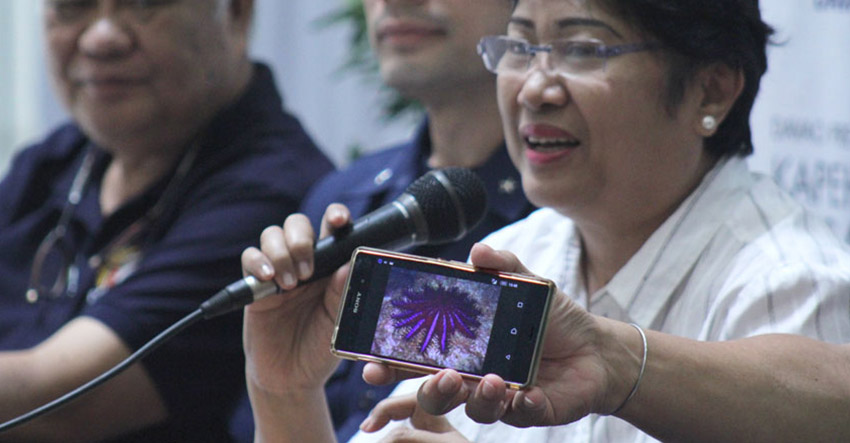
Fatima Idris, regional director of Bureau of Fisheries and Aquatic Resources (BFAR XI) shows to the members of the press what the Crown-of-Thorns starfish looks like. Idris said they are focused on the elimination of the said species, locally called as Dap-ag, on the upcoming coastal cleanup on Saturday as it causes destruction of coral reefs.(Ace R. Morandante/davaotoday.com)
DAVAO CITY – The Philippine Coast Guard with its Auxiliary in south eastern Mindanao and local government units will be holding the International Coastal Cleanup, said to be the biggest movement for cleaning the marine environment, on Saturday.
In a press conference on Monday, member of PCG Auxiliary Commodore Efren Elbanbuena said the annual clean up is a project of the The Ocean Conservancy, an international organization based in Washington, D.C. United States.
“The Ocean Conservancy has designated the PCG Auxiliary. This has been done in the previous years with the initiative of the Department of Environment and Natural Resources office and the Philippine Coast Guard,” he said adding that “maritime protection is one of the mandates of the PCG.”
On September 15, 2003, former President Gloria Macapagal Arroyo issued Presidential Decree No. 740 “Declaring the third Saturday of September of each year as the International Coastal Clean-up (ICC) Day in observance of the global coastal clean-up celebrations.”
“We have already sent our letters to local chief executives, especially the municipalities and the provinces and cities with coastal areas,” said Elbanbuena.
He said “the Philippines has 11,000 coastal barangays and as much as possible, we are covering these.”
“And for Region 11 it is not only along Davao Gulf, but even in Pujada Bay and east coast of Davao Oriental and as far as Sarangani Bay,” said Elbanbuena.
According to the PCG Auxiliary website the south eastern Mindanao area covers Davao City, Davao del Norte, Davao del Sur, Davao Oriental, Agusan Del Sur, Bukidnon, Maguindanao, North Cotabato, Sultan Kudarat, and Sarangani.
“We have a massive coastal clean up. Actually, the coastal cleanup is being done monthly,” he said, adding that the ICC is a continuing activity to minimize the trash in the oceans.
Elimination of crown-of-thorns starfish
Bureau of Fisheries and Aquatic Resources 11 Regional Director Fatima Idris said BFAR is focusing on the elimination or reduction of the number of crown-of-thorns starfishes on this year’s coastal clean-up. Crown-of-thorns are marine invertebrates that feed on corals.
“We would like to eliminate or reduce the numbers of crown-of-thorns or Dap-ag sa Bisaya. Dahil sila po yung sumisira ng mga corals natin. So sila po yung peste ng mga corals (They are the ones that damages our corals),” Idris said.
Idris said the said marine species propagates fast.
“That is what we are avoiding. We handle it very carefully and we see to it that we do not break it because even a small part of it, can grow to another crown-of-thorns,” she said.
Councilor Leo Avila III, who is also a member of PCG Auxiliary, explained that because of the imbalance in the marine ecosystem, the crown-of-thorns have grown in numbers.
He said that the natural predators of crown-of-thorns like the Budyong shells and the Napoleon wrasse is affected because of human consumption.
“A Napoleon wrasse is a fish but it is endangered and it is prohibited to catch it. But, there was a time that we tried ordering it in a Chinese restaurant here and we were secretly told to come back because their stock has just ran out,” he said.
“It means that they are still harvesting it which is prohibited,” said Avila adding that this has contributed to the proliferation of the crown-of-thorns.
Avila said it is important to protect the coral reef because it is like the “forest under the ocean”.
“Kung sa yuta pa ang coral reef mao ni siya ang forest (It is like the forest here in the land), where there is high biodiversity. If you notice the area where they throw dynamite is an area where there is a coral reef,” he said.
Idris added that damaged coral reefs take around “50 years or more” to grow back.
Last year, more than 107,000 Filipinos joined the ICC. (With reports from Ace R. Morandante/davaotoday.com)










